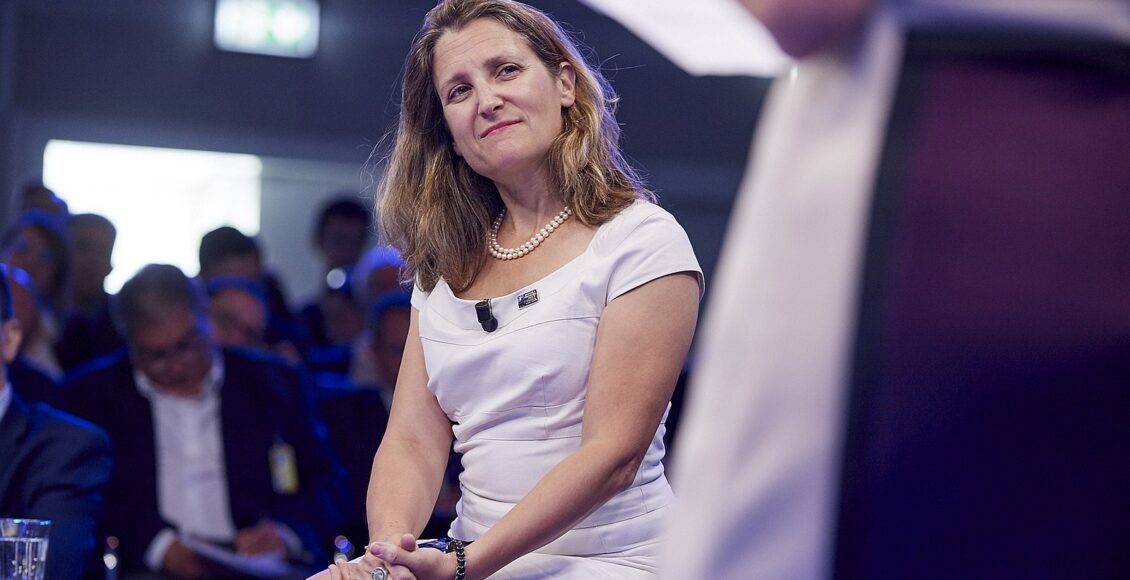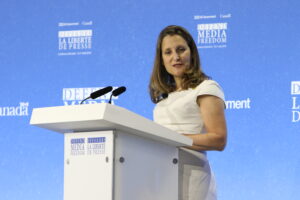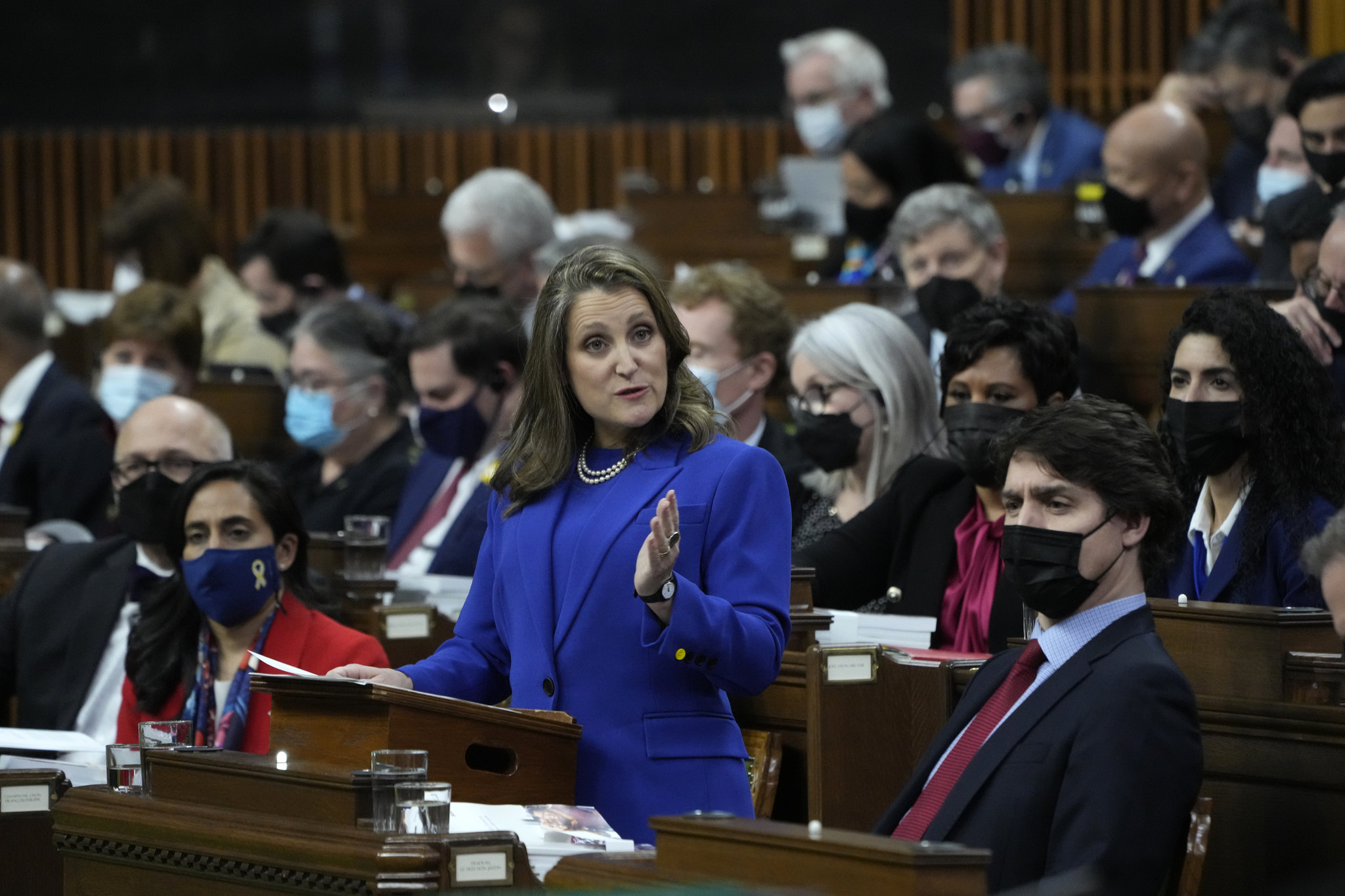Chrystia Freeland’s Undoing in a Party Trying to Move On from Justin Trudeau

Canadians are headed to the polls on April 28, after Prime Minister Mark Carney called a snap election on Sunday. The 45th Canadian federal election comes just 45 days after Carney was officially sworn in as prime minister, following a landslide victory in the Liberal leadership race where he earned 86 per cent of the vote to replace Justin Trudeau.
Despite the stunning reversal of fortunes for the Liberal party—now projected to win the most seats after being headed for electoral oblivion just a few months ago—the leadership race left one Liberal, Chrystia Freeland, with a stinging defeat. Mere months ago, Carney was a relatively unknown bureaucrat, while Freeland had worked her way into the upper echelons of Trudeau’s government, making it all the more disappointing for her that she received just 8 per cent of the vote in the Liberal leadership race.
In 2013, Freeland left a high-flying international career in journalism after being recruited by Trudeau to run in a downtown Toronto by-election, shortly after he secured the leadership of the Liberal party. In the decade following the Liberals’ sweeping majority victory in the 2015 election, Freeland held several prominent roles in Trudeau’s cabinet, quickly becoming a key member of his inner circle. She began as minister of international trade before being elevated to minister of foreign affairs, where she renegotiated the North American Free Trade Agreement—bolstering her reputation as a power player within the Liberal party. After the 2019 general election, Freeland was promoted to deputy prime minister, and in 2020, she was given the finance portfolio, arguably the most powerful cabinet position in the country.
As a rising star in Canadian politics, Freeland appeared perfectly positioned to take the reins of the Liberal party when the Trudeau era came to an end. But as Trudeau’s top lieutenant, she was left holding the bag for many of the government’s most unpopular decisions and was closely linked to the unfavourable economic conditions that ultimately led to Trudeau’s demise.

The collapse of Trudeau’s popularity can be traced to Canada’s weak economic recovery following the COVID-19 pandemic. Under the Liberal government, the country became mired in an economic tailspin marked by falling productivity and rising living costs—often described as “stagflation”—leading to a measurable decline in living standards. Canada was able to avoid a technical recession as real GDP grew by just 1.6 per cent in 2024—but that modest growth was almost entirely driven by record levels of immigration. In 2023, the population grew by 3.2 per cent, the fastest rate since 1957. Many economists now point to that surge as a key factor behind the steep rise in housing costs.
Though Canada’s declining real GDP per capita cannot be blamed solely on the Trudeau government, the broader effect of its economic policy was a chilling one: sluggish private investment, substantial capital outflows to more productive markets, and ballooning deficits. As minister of finance, Freeland bore the brunt of public frustration. While much of the economic turbulence was global in nature, she struggled to manage the narrative at home. In 2022, as Canadians grappled with a deepening cost-of-living crisis, Freeland drew heavy criticism for comparing her decision to cancel her family’s Disney+ subscription to the sacrifices Canadians were making to get by. The moment became symbolic of her political tone-deafness. Last year, she sparked fresh controversy by describing economic pressures as a “vibe-cession,” further damaging her appeal in the eyes of the Canadian electorate.
In December, the Liberal government’s economic credibility suffered another blow with the release of the fall economic statement. Just hours before it was scheduled to be tabled in the House of Commons, Freeland abruptly resigned from cabinet after Trudeau moved to replace her as minister of finance with Carney. The fall economic statement revealed a staggering projected deficit of $61.9 billion—$20 billion more than forecast in the spring budget.
In her resignation letter, Freeland wrote that she and Trudeau had found themselves “at odds about the best path forward for Canada.” Her departure was widely seen as a calculated effort to distance herself from the increasingly unpopular Trudeau, as internal pressure mounted and talk of a non-confidence vote intensified.

The shock of Freeland’s resignation directly precipitated Trudeau’s own, marking the end of his nearly decade-long tenure as prime minister and Liberal leader, and clearing the way for Freeland to run for the top job. Freeland publicly disavowed Trudeau’s “political gimmicks” and pledged to find alternatives to his signature environmental policy: the carbon tax. Still, throughout the Liberal leadership race, she struggled to create meaningful distance from Trudeau in the minds of Liberal voters trying to move on.
Over her 12 years in office, Freeland rose to become the second-most powerful figure in government and had built a reputation as Trudeau’s most loyal ally. That closeness—once her greatest strength—became her biggest liability. Despite Freeland’s attempt to seize on Trudeau’s unpopularity in her surprising resignation, she was ultimately pulled down in the Liberal leadership race by the very person who brought her into politics. And in the end, the words Trudeau offered during his resignation on January 6, when asked if her departure had catalyzed his own, did not grant her distance—but tied her even more firmly to his legacy: she “has been an incredible political partner through just about everything we have done as a government…for the past decade.”
Edited by Maisie Minnick
Featured Image: “Chrystia Freeland – NATO Engages – The Brussels Summit Dialogue – 2018 (MIC0049)” by MSC / MCI is licensed under CC BY 3.0.
